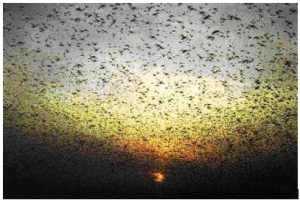

Like all insects the grasshopper has six legs, a head, thorax, and abdomen. Molting several times during its lifespan, it also has an exoskeleton which is a hard outer surface that protects its softer insides in an overlaying fashion similar to armor plating. A combination of two compound and three conventional eyes allows them to have situational awareness in almost every direction.
For those of the species that possess airborne capabilities, they have two pairs of wings; the back larger than the front which are small and fairly hard. Their back legs are large allowing them to jump over 20 times as far as their body length at 8 to 12 miles per hour. While that does not seem like much at human scale, for the grasshopper it is covering ground at a tremendous amount of speed. This is equivalent to jumping 40 yards in a tenth of a second, which would scale to moving over 800 mph and breaking the sound barrier.
Grasshoppers consume plants, primarily leaves, grasses, and cereal crops. In times of endemics, copious amounts of food and feed stock are destroyed causing serious problems for everyone not just farmers. This effect is observable and reflected in the commerce of agricultural commodities causing a ripple effect across financial markets. These insects live all around the world except where it is too cold like the north and south Polar Regions, adapting to most every habitat including deserts, forests, and grasslands. Latchininsky explains in his paper that “…out of more than 12,000 described grasshopper species in the world, only about a dozen exhibit pronounced behavioral and/or morphological differences between phases of both nymphs and adults, and should be considered locusts.” And in fact, the tendency to swarm together is a relatively recent phenomenon in grasshopper evolution. In the same way that a mass gathering of baboons is called a congress, large groups of grasshoppers and locusts are indeed referred to as plagues.
At times there are events occurring with uncharacteristic swarming by members of the Acrididae family, which are the non-swarming members of the grasshopper designation. Acting as a monolithic event, this has happened roughly a dozen times in evolutionary history. While these occasional gatherings do not mean that these grasshoppers are locusts, they are exhibiting genetically programmed behavior in an instinctual fashion on a biochemical related psychological level. Scientists have only discovered a dozen or so true locust species in which the increase of density causes behavior changes followed by physiological, morphological and other phenotype changes. Extreme weather conditions induced by an uncharacteristacally wet warm season coupled with a dry winter will statistically allow greater chances in the survival of egg deposits resulting in a mass emergence in the spring. This phenomenon lends itself to be a case of too many grasshoppers in too little space as opposed to a proclivity to swarm, however the effects of elevated pheromones does play a major factor in behavioral development during the species’ breeding cycles.
Grasshopper/locust transformation happens at a genetic level. New studies are examining different levels and types of evolutionary triggers. It turns out that one Asian species of locust, Locusta Migratoria Manilensis, morphs backwards into a benign grasshopper after getting infected by a parasite called Paranosema Locustae.
When infected, the reduction in aggregation pheromone reduces levels of serotonin and dopamine, which work synergistically to initiate, induce, and maintain gregarization of migratory locusts. The mutual inhibition between gut microbiota and parasites with impaired swarm behavior of locusts could be exploited to develop novel microsporidian formulas and application technologies to enhance the ability of P. locustae to control locusts.
